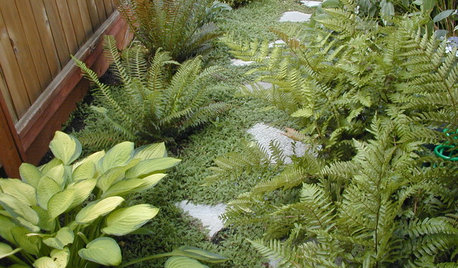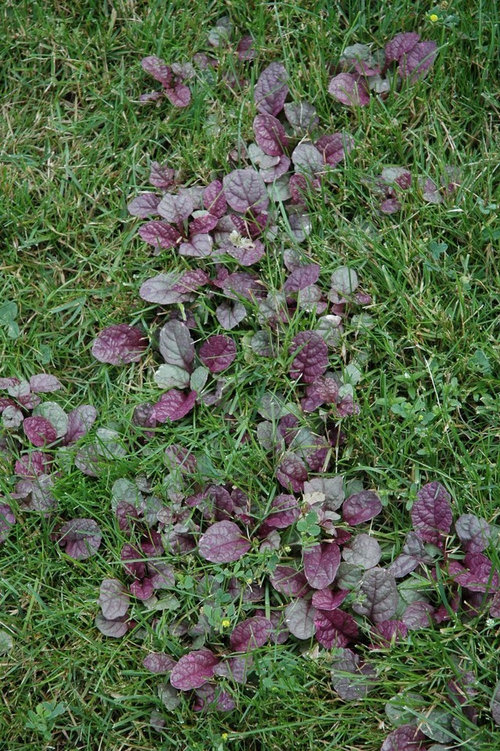ajuga ground cover growing in lawn....Roundup?
WorBry
10 years ago
Featured Answer
Comments (23)
ianna
10 years agolast modified: 9 years agoWorBry
10 years agolast modified: 9 years agoRelated Discussions
Need help deciding on an Ajuga for a ground cover!
Comments (3)Burgundy Lace does look really pretty, but I need the dark leaves for this spot. Maybe I can use that in a different location. . Atropurpurea sound like more of a species. Unless I can see that one in person, and get more of an idea of leaf shape and color, I'm leaning more towards one of the others. This post was edited by linnea56 on Mon, Apr 28, 14 at 14:54...See MoreMixing ground covers?
Comments (5)I prefer to grow large expanses of groundcovers next to each other. For example, in my front yard, my large expanse of soapwort abuts another large expanse of veronica pectinata. Be aware that ajuga reptans is considered invasive in some areas of the country. So check with your county extension office to make sure it isn't invasive in your area. Also, if one of the groundcovers is significantly taller than the other, the taller groundcover may eventually shade out the shorter groundcover. Other than those caveats, I would say that you could just pick the two or three that look best to you and go for it. All of the ones that you mentioned will grow in shade.or part-sun in most areas of the country....See MoreGround cover - Ajuga vs Vinca Minor
Comments (3)Yes more than likely both of those will choke out your existing plants. At the very least you will be constantly working to keep them under control. I agree that Asarum is a beautiful and less aggressive choice. Arum would work well too. Particularly Arum Italicum....See Morehow to cover the waterfall slope with ground cover plant?
Comments (3)If you live in New York as suggested in your name, you might want to search on cliffandjoann. They built a stunningly beautiful pond and have explained the details. They say that some of their plants are in pots. I use impatiens and am under the impression that they will grow without much actual soil. It is certainly true for water cress (from the grocery store) anchored directly in flowing water. For something larger, sweet flag will certainly work. You can also use vines or other plants growing beside or near the area. You can also add logs or other natural materials for interest and coverage....See Moreianna
10 years agolast modified: 9 years agoWorBry
10 years agolast modified: 9 years agoianna
10 years agolast modified: 9 years agoianna
10 years agolast modified: 9 years agoSouthCountryGuy Zone 4b-5 SE BC
10 years agolast modified: 9 years agoWorBry
10 years agolast modified: 9 years agoSouthCountryGuy Zone 4b-5 SE BC
10 years agolast modified: 9 years agoWorBry
10 years agolast modified: 9 years agoWorBry
10 years agolast modified: 9 years agoSouthCountryGuy Zone 4b-5 SE BC
10 years agolast modified: 9 years agoWorBry
10 years agolast modified: 9 years agoSouthCountryGuy Zone 4b-5 SE BC
10 years agolast modified: 9 years agoWorBry
10 years agolast modified: 9 years agoSouthCountryGuy Zone 4b-5 SE BC
10 years agolast modified: 9 years agoSouthCountryGuy Zone 4b-5 SE BC
10 years agolast modified: 9 years agoWorBry
10 years agolast modified: 9 years agoSouthCountryGuy Zone 4b-5 SE BC
10 years agolast modified: 9 years agoSouthCountryGuy Zone 4b-5 SE BC
10 years agolast modified: 9 years agoWorBry
10 years agolast modified: 9 years agoSouthCountryGuy Zone 4b-5 SE BC
10 years agolast modified: 9 years ago
Related Stories

GROUND COVERSGround Force: 10 Top Ground Covers for Your Garden
Protect your soil from weeds and drought this summer with a living mulch of ground covers
Full Story
GARDENING GUIDES6 Dependable Ground Covers for Warm Climates
Swap some lawn for these drought-tolerant clumping plants — and watch your maintenance efforts diminish while they easily grow
Full Story
LANDSCAPE DESIGN6 Great Ways With Garden Ground Covers
Use them as problem solvers, weed killers, color and texture providers ... ground cover plants have both practical and visual appeal
Full Story
GROUND COVERSGive Your Lawn a Taste of the Wild
Consider the joys of an irregularly trimmed meadow lawn: It’s ecofriendly, visually interesting and still good for romping
Full Story
GARDENING GUIDES5 Great Grasses for a New Lawn
Learn about maintenance, wear tolerance, ideal climate and more for these top turf choices to pick the right one for you
Full Story
GARDENING GUIDESGreat Design Plant: Bugle Weed, a Quick Ground Cover
It’s highly adaptable, suppresses weeds, reduces erosion and provide weeks of bright flowers. Just watch for invasiveness
Full Story
LANDSCAPE DESIGN15 Great Ideas for a Lawn-Free Yard
End the turf war for good with hardscaping, native grasses and ground covers that save water and are easier to maintain
Full Story
FLOWERS AND PLANTSMyoporum Parvifolium a Lush Green Alternative to the Lawn
Plant this Australian native in mild-winter climates as a low-maintenance, semi-drought-tolerant ground cover
Full Story
LANDSCAPE DESIGN7 Low-Maintenance Lawn Alternatives
Turf isn't the only ground cover in town. Get a lush no-grass lawn with clover, moss and other easy-care plants
Full Story
MOST POPULARMeet a Lawn Alternative That Works Wonders
Carex can replace turfgrass in any spot, is low maintenance and adjusts easily. Add its good looks and you’ve got a ground cover winner
Full StorySponsored
More Discussions





violetsnapdragon